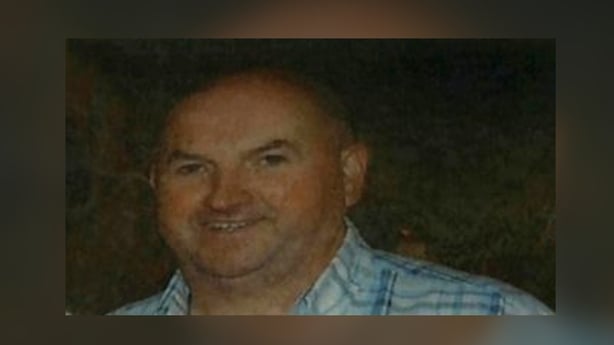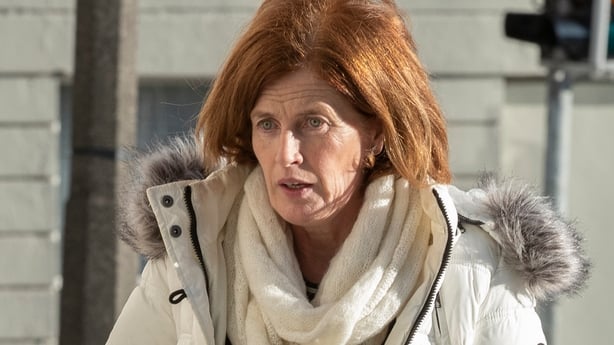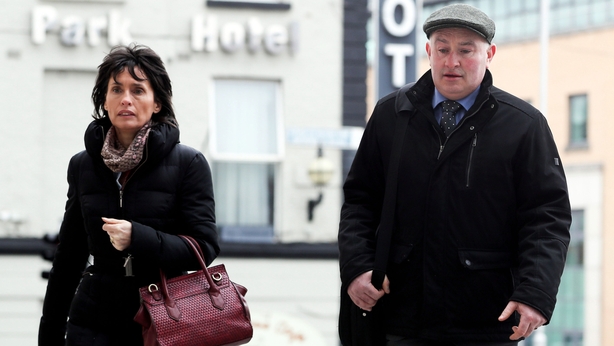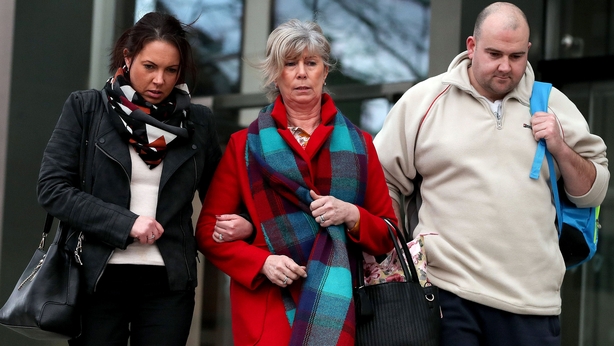"Da, are you not working today?"
The simplicity of the question, its affectionate and familiar tone pierced the otherwise technical and mundane nature of the evidence that day in court 13.
A garda expert was taking the jury through page after page of mobile phone records, tracking traffic from one number to another when the contents of Robert Ryan’s last text message to his father Bobby was identified among hundreds of other communications.
It was sent at 10.44am on 3 June 2011, the day Bobby Ryan, a Tipperary DJ known as Mr Moonlight disappeared.
It was early on in what was to become the longest criminal trial in memory. The salacious stories of the accused Pat Quirke and Mary Lowry’s affair had already grabbed the headlines and eclipsed the main event: the brutal murder of Bobby Ryan.
When his son’s text message was read out in court it was a poignant reminder that behind those headlines and the formal legal process, was a real family tormented by very real questions.
On that summer’s day almost eight years previously, their anguish was just beginning.
Bobby Ryan’s boss Niall Quinn had called to their home wondering why the usually diligent and punctual employee, had not shown up to drive his truck from the quarry that day.

Robert, equally concerned when he saw his father’s work boots and clothes still in the hallway, sent the text at 10.44am in hope of solving the mystery.
"Da, are you not working today?" he asked.
He never got an answer because the message never reached its intended recipient. Fifteen minutes earlier, Bobby Ryan’s phone signal had pinged off a local mast before it was lost forever. The phone was never found.
It was the last question Robert Ryan had asked his father but the first of many, many more that would haunt the Ryan family for years to come.
What exactly happened to Bobby Ryan after he left his girlfriend’s house around 6.30am will probably never be known. That question still haunts the Ryan family.
Their daily attendance at court 13 on the fourth floor of the Criminal Courts of Justice from January until the first day of May did little to provide answers.
Treated initially as a missing person investigation, no crime was suspected in Bobby Ryan’s disappearance.
While searches and interviews were carried out, the forensic process normally activated in a murder inquiry did not kick in until 22 months later and in the meantime vital evidence may have been lost.
The defence had described the investigation as "sub optimal" and pointed to "systems failures".
Searches of the farm at Fawnagowan took place soon after Mr Ryan disappeared. Nothing was found despite the fact that pathologists said such a violent killing would have left a very bloody scene.

Fingerprints taken on Bobby Ryan’s van were not compared against the accused until this year when the trial was already under way. They did not match those of the accused but it was another gap in the investigation that went unexplained, another question to be asked. There were other questions too.
If Mr Ryan’s van left the yard less than ten minutes after he left the house, had he been killed and his body left somewhere, to be stripped naked and dumped in an underground tank later or could it all have taken place in those few minutes?
Did his killer drive the van and abandon it in a car park at Bansha Woods? If so how did he get back to the farm?
There was no murder weapon identified, no precise time or location for the killing. The pathologist who carried out the post mortem said the cause of death was blunt force trauma either from an assault or a vehicle strike.
But Khalid Jaber who no longer works in Ireland did not attend the trial.
His report was peer reviewed by colleagues who concluded the injuries were more likely to have been caused by a vehicle. But the prosecution did not call these pathologists as witnesses.
Instead the former state pathologist for Northern Ireland, Professor Jack Crane, was asked to review Dr Jaber’s report and give evidence at the trial.
He did not agree that the injuries were consistent with Mr Ryan having been hit by a vehicle. He believed they were more likely to have been caused by an assault.
He said Mr Ryan had sustained "severe head injuries" due to blows to the head with a blunt object or as a result of being crushed or compressed.
The rib fractures could have been caused by a blow to the back or by falling into the tank, Professor Crane said.
The fracture to the thigh bone was consistent, he said, with a heavy blow from a bat. He said he had seen similar injuries as a result of punishment beating style attacks in Northern Ireland in which baseball bats were used.
Referring to the suggestion that the injuries were caused by a vehicle he said it is possible but, "there is no real evidence to support this".
Usually, he said, leg injuries caused by vehicle impacts occur below the knee, although he accepted that the height of the victim and other factors would have to be taken into account.
He also noted that pedestrians struck by cars usually suffer a single head impact when they hit the ground which would not cause multiple fractures to the skull as seen in this case.
The defence called Acting State Pathologist Dr Michael Curtis who said the most likely mechanism for Mr Ryan's injuries was "vehicular impact trauma, that is, a person being struck by a moving vehicle".
He added that a beating with a baton or baseball bat was also possible.
He explained the presence of multiple fractures to the head saying that sometimes when a pedestrian is struck by a vehicle the head strikes the vehicle and then the ground, leading to multiple fractures.
The prosecution said it would have preferred a more complete forensic picture but there were circumstances where even when a body has not been found that a jury can reach a verdict.
Prosecuting counsel Michael Bowman said Pat Quirke’s motive had been established "in a multiplicity of ways".
His yearning to resume his affair with Mary Lowry and his financial dependency on her - love and money - were two of life’s greatest motivators, Mr Bowman said.

In the 'Dear Patricia' agony aunt letter, Quirke had written that his love rival Bobby Ryan had promised Mary Lowry everything he could not.
There were only a handful of people familiar with the underground tank and Pat Quirke had unlimited access to it.
The internet searches on decomposition communicated a "curiosity not easily explained away".
It was beyond a coincidence that the searches took place on 3 December 2012 - the same day Quirke had been caught on CCTV around Mary Lowry’s home, taking her underwear from her clothes line and peering in her windows - an event which led to her telling him she wanted him off the land.
"The clock was ticking and it is an affront to common sense to say these events were unrelated," he said. The staged discovery of the body happened because Pat Quirke’s position on the farm was compromised, time was ticking down and his options were limited so he made a decision to return the remains of Bobby Ryan.
In his garda interviews, Quirke had said such suggestions didn’t make sense. If he wanted to hide a body, why not simply fill in the tank with soil.
But Mr Bowman said this ran the risk of it being discovered later by whoever would take over the farm so Quirke took a gamble on staging the discovery and immediately creating a narrative pointing the finger at Mary Lowry.
He said Quirke appeared to be speaking from a prepared script raising questions about Mary Lowry’s attitude to and knowledge of her boyfriend’s disappearance. His words were strikingly similar to what gardaí had discovered on a sheet of paper found in his home.
Mr Bowman had cited case law on circumstantial evidence, reminding the court that "independent facts, each of them in itself insufficient to prove the main fact, may yet, either by their cumulative weight or still more by their connection of one with the other as links in a chain, prove the principal fact to be established".
Even if a case contained weaknesses or was vague or contained significant inconsistencies as argued by the defence, it was for the jury to assess that, he said.
What the jury didn’t know was that audio sex tapes involving Pat Quirke and Mary Lowry were found during a search of Quirke’s home.
Defence lawyers successfully applied to keep this and other evidence from the jury in one of a number of applications about the admissibility of evidence.
The jury did not hear about these recordings along with other evidence including articles about murderer Joe O’Reilly, missing woman Jo Jo Dullard and murder victim Siobhán Kearney which were found on a home computer.
The sex tapes contained "very little dialogue" and were of "an intimate nature" the court was told. There were also recordings of Pat Quirke and his wife Imelda.

The judge ruled the jury should hear one recording of a conversation between Mary Lowry and her then boyfriend Flor Cantillon, but agreed with the defence that the sex tapes were more "prejudicial than probative" and might lead a jury to "attribute some strange sexual proclivity" to Patrick Quirke.
In other words, they might unfairly influence a jury against the accused while not establishing anything of significant evidential value.
Another piece of evidence the prosecution was not allowed to introduce was a reconstruction of the discovery of Bobby Ryan’s body.
The gardaí believed their reconstruction, using a dummy, would show that Mr Quirke could not have seen what he claimed to have seen when he first removed the lid of the tank.
Mr Ryan’s remains were badly decomposed, having lain in the disused underground tank for 22 months.
Gardaí did not believe it was possible to tell at that stage that the body was naked which is what Mr Quirke had reported at the time.
The defence had argued that the reconstruction was not carried out by an independent person and that the accused man was not afforded an opportunity to have a solicitor or engineer present.
The judge ruled that while the reconstruction was relevant and admissible, there were "frailties" in the evidence and therefore it should be ruled out of the trial.
The defence had unsuccessfully argued that the absence of hard evidence against his client should render the case unsafe to be put before the jury for consideration.
Senior Counsel Bernard Condon said the essential matter in this case was what happened to Bobby Ryan and there was "actually no evidence, good, bad or indifferent".
The circumstantial evidence did nothing more than establish merely that there is some interconnection of the personalities as opposed to anything of substance, he argued.
"It does not prove a killing, it merely proves that someone might want someone out of the way. It is quite a leap to say if someone has motive to continue a relationship that motive of itself is an intention to kill. The prosecution must prove that intention to kill.
"The prosecution must prove beyond a reasonable doubt that Pat Quirke killed Bobby Ryan and motive will not achieve this. Motive could be seen as a desire to reestablish a relationship but to take it a step further to say it is a desire to kill was an abuse of the English language," he argued.
Mr Condon described a "chasm of evidence" in relation to 3 June 2011, the day Bobby Ryan went missing. There was no forensic evidence, no fingerprints, no eyewitnesses, no CCTV. It was a case of speculation based around events of the 3rd of June and "if you can’t say anything about the killing you cannot say anything about the murder".
If the height of the prosecution evidence was that Mr Ryan suffered blunt force trauma, it was not known beyond a reasonable doubt what gave rise to it.
There was the possibility of a car and on the burdens and standards of proof the onus was on the prosecution to rule that out and it had not done so, he said. How then could a jury beyond a reasonable doubt come to the conclusion that it was not a car.
"If you know nothing about the killing, how can you say it was murder?" he asked.
The suggestion of a staged discovery of the body did not prove murder either, nor did computer searches about decomposition of remains.
"Suspicion of knowledge of a body being hidden did not establish a body being hidden in these particular circumstances," he said adding "a bit of suspicion at the end about computer searches does not establish evidence pre the disappearance of Bobby Ryan. We are talking about murder, we are talking about what happened on the 3rd of June 2011... none of it will establish anything other than suspicion but that is not enough. In the absence of evidence of killing, suspicion does not fix it," he had argued in an application in absence of the jury to stop the trial after 13 weeks of prosecution evidence.
Ms Justice Eileen Creedon had told the jury that circumstantial evidence could be powerful but must be examined with care. She said they could not speculate or fill in the gaps.
The jury took more than 20 hours since Tuesday of last week before returning a 10:2 majority guilty verdict. Bobby Ryan’s family broke down on hearing the verdict.

Their victim impact statement made it clear they are still tormented by many unanswered questions. Michelle Ryan, who with her mother Mary and brother Robert had maintained a dignified presence in court in the face of the most distressing evidence, described how their lives and world were torn apart.
To this day they wonder about the circumstances of Mr Ryan’s violent death. "The mental anguish, wondering every day was Daddy calling out for help? Was he calling our names for help?"
The person who might have answered those questions sat just feet away from them as he had throughout the 15-week trial. Staring ahead or glancing down as he had each day, he showed no emotion, gave nothing away. He did not leave court as usual on Wednesday however, instead he was beginning a life sentence.
The Ryan family linked each other as they walked from the Criminal Courts, their unanswered questions remain, but they said they got justice for Mr Moonlight.







